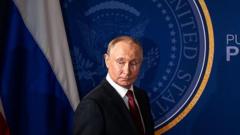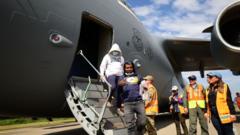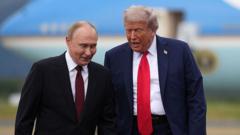The advancement of hypersonic missile technology highlights the growing military capabilities of China and Russia, leaving the US and UK scrambling to keep pace. The unique characteristics of these missiles, including their speed and maneuverability, pose significant challenges to defense systems worldwide.**
Rising Tensions: The Global Race for Hypersonic Weapons**

Rising Tensions: The Global Race for Hypersonic Weapons**
As nations invest heavily in hypersonic missile technology, a new arms race emerges, raising geopolitical tensions and altering warfare dynamics.**
---
In a striking display at Beijing’s National Day parade on October 1, 2019, China showcased its Dongfeng (DF-17) hypersonic missiles, shifting the balance of military power and prompting global apprehension. These advanced weapons, capable of traveling at speeds exceeding five times the speed of sound, combine both speed and maneuverability, fundamentally changing confrontation dynamics in modern warfare.
William Freer, a national security fellow at the Council on Geostrategy, emphasized that the current advancements symbolize an emerging geopolitical landscape, reminiscent of Cold War tensions. China leads the hypersonic arms race, effortlessly ahead of Russia, while the US trails in efforts due to a historical focus on counter-terrorism and insurgencies.
Countries like Israel and Iran are also entering this arena, with Iran asserting an operational hypersonic missile that allegedly targeted Israel during recent conflicts. North Korea has made strides as well, albeit with varying claims about its missile capabilities. As these nations ramp up development, the US and UK are reinforcing their strategies, unveiling the 'Dark Eagle' hypersonic weapon amidst concerns over the technological gap.
Hypersonic missiles, traveling at Mach 5 or faster, present distinct challenges in terms of detection and interception compared to subsonic or supersonic missiles. The complexity lies not just in achieving speed, but also in maintaining agility to evade traditional tracking systems. Missiles like Russia’s Avangard and Kinzhal, alongside China’s latest hypersonic creations, raise alarms regarding their destructive capabilities and the potential for unprecedented conflict escalation.
The US Congressional Research Service report has spotlighted the inadequacies of current US sensors to track these missiles, hinting at a need for improved surveillance systems to enhance defense mechanisms. Experts note that while hypersonic weapons may not entirely revolutionize warfare, the reduced response time elevates the stakes for offensive and defensive military strategies.
Although both Russia and China present formidable advancements, commentators like Dr. Sidharth Kaushal express a modicum of skepticism about their purported capabilities, advocating for caution against overstated fears. Meanwhile, the UK is striving to reclaim its foothold in this competitive domain, highlighting successful propulsion tests in collaboration with US counterparts. However, experts caution that significant progress is still necessary before these hypersonic capabilities can be fully operational.
The escalating competition signifies a more complex global landscape, where nations seek not only offense innovations but also defensive countermeasures. With each advancement in hypersonic technology, the nature of military engagement evolves, reminding all parties that the interplay of offense and defense remains as critical as ever.
In a striking display at Beijing’s National Day parade on October 1, 2019, China showcased its Dongfeng (DF-17) hypersonic missiles, shifting the balance of military power and prompting global apprehension. These advanced weapons, capable of traveling at speeds exceeding five times the speed of sound, combine both speed and maneuverability, fundamentally changing confrontation dynamics in modern warfare.
William Freer, a national security fellow at the Council on Geostrategy, emphasized that the current advancements symbolize an emerging geopolitical landscape, reminiscent of Cold War tensions. China leads the hypersonic arms race, effortlessly ahead of Russia, while the US trails in efforts due to a historical focus on counter-terrorism and insurgencies.
Countries like Israel and Iran are also entering this arena, with Iran asserting an operational hypersonic missile that allegedly targeted Israel during recent conflicts. North Korea has made strides as well, albeit with varying claims about its missile capabilities. As these nations ramp up development, the US and UK are reinforcing their strategies, unveiling the 'Dark Eagle' hypersonic weapon amidst concerns over the technological gap.
Hypersonic missiles, traveling at Mach 5 or faster, present distinct challenges in terms of detection and interception compared to subsonic or supersonic missiles. The complexity lies not just in achieving speed, but also in maintaining agility to evade traditional tracking systems. Missiles like Russia’s Avangard and Kinzhal, alongside China’s latest hypersonic creations, raise alarms regarding their destructive capabilities and the potential for unprecedented conflict escalation.
The US Congressional Research Service report has spotlighted the inadequacies of current US sensors to track these missiles, hinting at a need for improved surveillance systems to enhance defense mechanisms. Experts note that while hypersonic weapons may not entirely revolutionize warfare, the reduced response time elevates the stakes for offensive and defensive military strategies.
Although both Russia and China present formidable advancements, commentators like Dr. Sidharth Kaushal express a modicum of skepticism about their purported capabilities, advocating for caution against overstated fears. Meanwhile, the UK is striving to reclaim its foothold in this competitive domain, highlighting successful propulsion tests in collaboration with US counterparts. However, experts caution that significant progress is still necessary before these hypersonic capabilities can be fully operational.
The escalating competition signifies a more complex global landscape, where nations seek not only offense innovations but also defensive countermeasures. With each advancement in hypersonic technology, the nature of military engagement evolves, reminding all parties that the interplay of offense and defense remains as critical as ever.



















